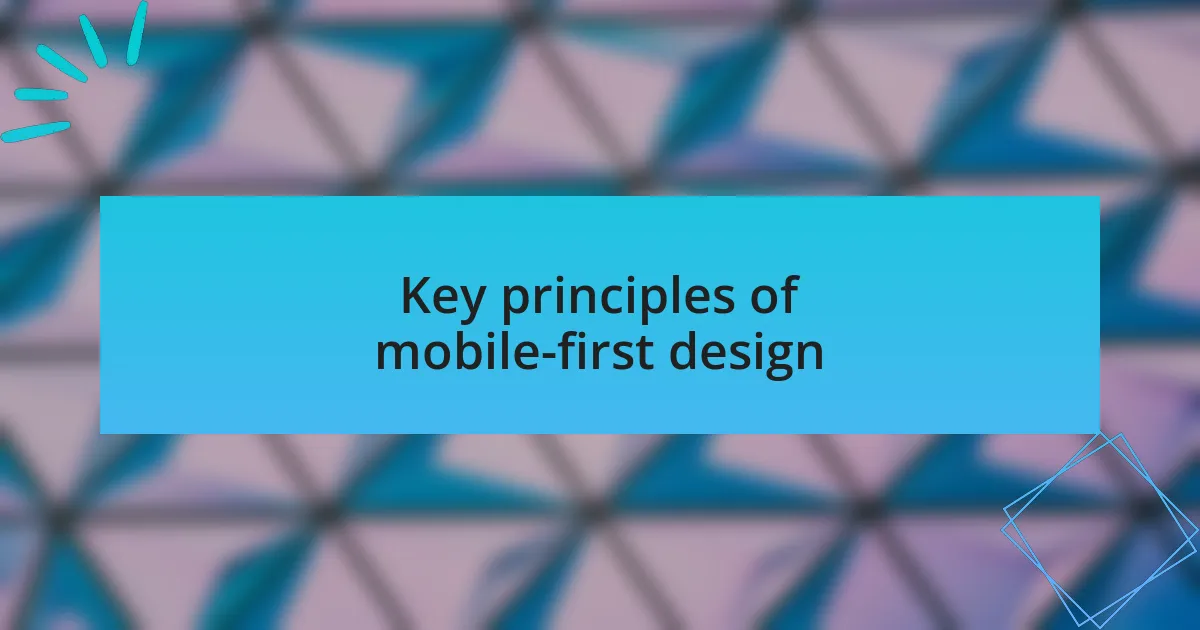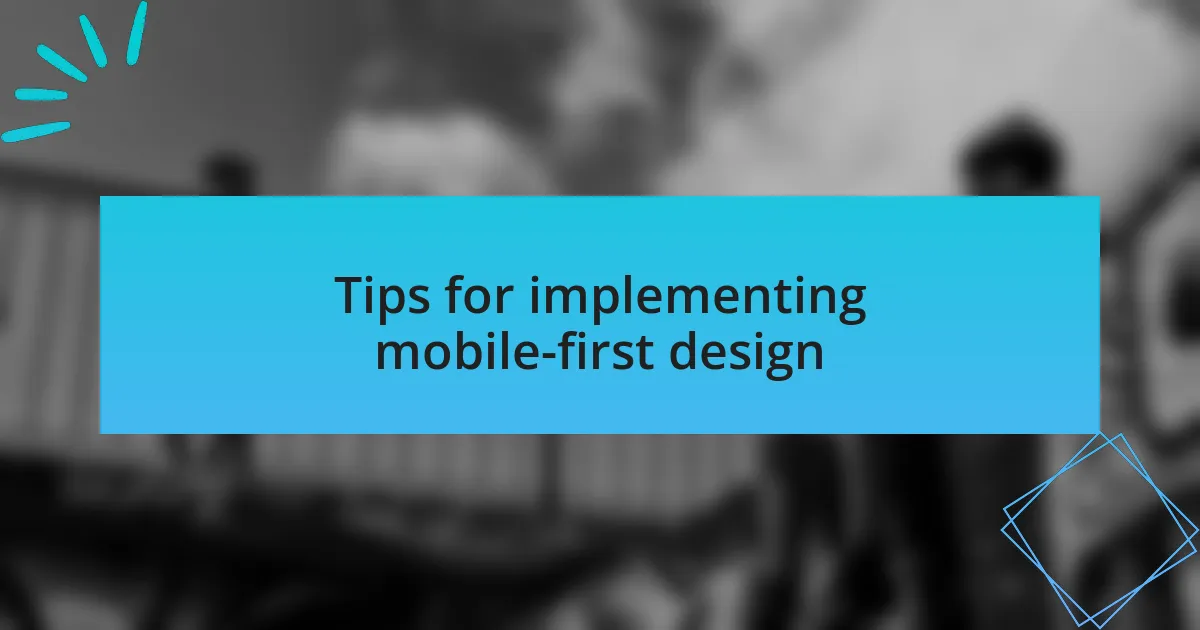Key takeaways:
- Mobile-first design prioritizes smartphones, enhancing user experience and engagement by focusing on essential content and touch-friendly interfaces.
- This approach significantly impacts SEO, as search engines favor mobile-friendly designs, leading to improved visibility and traffic.
- Implementing mobile-first design can streamline development processes, reduce revisions, and position agencies as modern leaders in the market.
- Key challenges include adapting complex layouts to smaller screens and ensuring fast loading times, which require ongoing testing and stakeholder education.

Understanding mobile-first design
Mobile-first design is a philosophy that prioritizes designing for smartphones before desktops. From my experience, this approach reflects the reality that many users today access websites primarily through their mobile devices. It makes me wonder—how often do you find yourself scrolling through content on your phone versus a laptop? For me, it’s increasingly the norm.
When I first started embracing mobile-first design, I noticed a shift in how I approached user experience. It forced me to strip down content to its essentials, focusing on clarity and ease of use. I remember redesigning a client’s website, where transitioning to mobile-first not only improved loading times but also enhanced user engagement significantly. It was rewarding to see the positive feedback pour in.
One key aspect I’ve learned is the importance of touch-friendly interfaces. Think about it: how many times have you struggled clicking tiny links or buttons on a mobile site? This realization has shaped my design choices—prioritizing larger touch targets ensures a smoother experience. In reflecting on these design choices, I see how they genuinely impact user satisfaction and retention.

Importance of mobile-first design
Mobile-first design is crucial for meeting user expectations in today’s digital landscape. I’ve encountered situations where switching to a mobile-first approach revealed just how many site visitors were navigating via their smartphones. For instance, during one client project, we found that 70% of users accessed the site on mobile. Those numbers profoundly influenced our design approach—suddenly, we had to cater to these users first and foremost.
In my experience, a mobile-first strategy significantly impacts SEO and site performance. Search engines, like Google, prioritize mobile-friendly designs, which is something I’ve learned the hard way. A while back, I worked on a project where we initially neglected mobile optimization. The site’s rankings suffered, and it was a wake-up call. After adopting a mobile-first mindset, we saw a remarkable improvement in search visibility and organic traffic.
Moreover, I believe mobile-first design fosters creativity and innovation. When I’m restricted to a smaller screen, I’m forced to think outside the box and focus on core functionality. I often remind myself that constraints can lead to some of the best ideas—how have limitations inspired your own creativity? I’ve personally designed interfaces that not only cater to small devices but also provide engaging experiences that resonate with users across platforms.

Key principles of mobile-first design
Mobile-first design hinges on the principle of prioritizing essential content and functionalities. I remember a project where we stripped down all the non-essential elements for a mobile version, which led to a cleaner, faster experience. This not only made navigation smoother for users but also highlighted the importance of clarity and simplicity—two key components of effective design.
Another crucial principle is ensuring responsive design. I’ve seen too many websites where the mobile experience feels like an afterthought. During a redesign for a client, we focused on fluid grids and flexible images, which transformed the usability across devices. This approach underscores the necessity of catering to a wide range of screen sizes, making sure that every visitor feels at home, regardless of the device they use.
Lastly, I can’t stress enough the importance of touch-friendly design elements. My journey as a designer has taught me that buttons and links need to be easy to tap, without requiring a magnifying glass. For example, when revamping a local restaurant’s website, we made sure that key features were accessible with just a finger. This not only enhanced user satisfaction but also led to increased bookings, proving that a thoughtful mobile-first design can drive real results. How could you adapt your own designs to better accommodate touch interactions?

Benefits for design agencies
Design agencies that embrace mobile-first design can see a significant boost in client satisfaction. I recall working with a tech startup where we implemented mobile-first principles, resulting in an increase in their customer engagement metrics almost immediately. Clients appreciate how a seamless user experience directly translates into higher retention rates and positive feedback from their audience.
Additionally, focusing on mobile-first design can streamline the development process. Early in my career, I was involved in a project where we tackled the mobile version first, and to my surprise, it simplified the desktop version. This approach often leads to fewer revisions and a more efficient workflow, ultimately saving both time and resources for design agencies.
When design agencies adopt a mobile-first mindset, they position themselves as forward-thinking leaders in the market. I’ve found that clients often gravitate towards agencies that prioritize modern web standards. Have you ever noticed how a well-executed mobile design sets a tone of professionalism and reliability? This perception can open doors to more opportunities and collaborations, fueling growth in an increasingly mobile-centric digital landscape.

Challenges in mobile-first design
Mobile-first design definitely has its challenges, and I remember diving into one project where the limitations of smaller screens became immediately apparent. I found it complex to fit intricate layouts into a mobile format without compromising content quality. Have you ever tried to make a multi-column layout work on a phone? It’s a real puzzle, and this often leads to creative constraints that can frustrate both designers and clients alike.
Another obstacle I encountered was ensuring that loading times remained swift on mobile devices. While optimizing images and resources, I realized that striking the right balance between quality and speed was essential. It’s a balancing act that can be challenging but rewarding; there’s nothing like witnessing a client’s relief when a site performs smoothly across devices after overcoming such hurdles.
Lastly, it’s not uncommon to face pushback from stakeholders who may be more comfortable with traditional desktop-first approaches. I can recall a discussion with a client who struggled to understand the mobile-first rationale. Bridging that gap took time and patience, but ultimately, it reinforced the importance of education in our industry. Have you had similar conversations? It can be eye-opening to realize that the path to mobile-first isn’t just about designs; it’s also about reshaping mindsets.

Tips for implementing mobile-first design
When implementing mobile-first design, one key tip is to prioritize your content. In my experience, the smaller screen size compels you to identify what truly matters. I remember a project where I had to strip down pages to their essentials. It felt liberating but also daunting to focus solely on core messages. Have you ever had to make that tough call about what to keep and what to cut?
Another effective strategy is to utilize responsive frameworks that adapt beautifully across devices. I have always leaned on frameworks like Bootstrap or Foundation because they simplify the process of creating a mobile-first layout. The moment I began integrating these tools, I noticed a significant reduction in development time. It’s incredible how a little planning with the right frameworks can save headaches down the road.
Don’t forget about testing! In my work, I’ve often found that even the most well-thought-out designs can falter unless rigorously tested. I recall a specific launch where users encountered frustrating navigation issues on mobile, which we only discovered post-launch. Engaging real users for feedback early and often is crucial; it not only enhances the design but also offers peace of mind before rolling anything out to the public. Have you ever launched a design that didn’t perform as expected? It’s a lesson worth learning early.